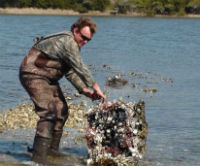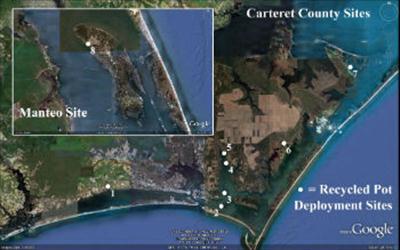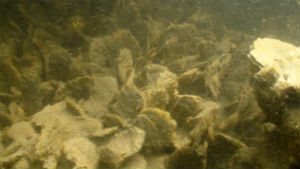 Crab pots are placed in a line in the Rachel Carson Reserve near Beaufort. Photo: UNC Institute of Marine Sciences. |
MOREHEAD CITY — Derelict crab pots, once destined for landfills, are back in coastal waters with a new lease on life.
Marine scientists from the University of North Carolina’s Institute of Marine Sciences in Morehead City, are working with commercial fishermen to transform abandoned or lost crab pots into novel “artificial reef balls” that could enhance oyster habitat – and future oyster populations.
Supporter Spotlight
The trash-to-treasure project underscores the connection between healthy habitats and healthy fisheries, says Joel Fodrie, a UNC assistant professor of coastal biological oceanography, who is heading up the research effort.
“Many of my commercial fishing friends lament about disappearing substrate for oyster larvae to settle and survive,” Fodrie points out. “Yet, out on the water we all come across abandoned or lost crab pots covered with oysters.”
With their observations come questions: Could derelict crab pots be revamped to provide suitable material to capture oyster larvae in the water column? Would young oysters be better protected from predators raised above the flat bottom? And, where would such experiments work best?
“It seems likely that survival rates could increase if we keep young oysters higher in the water column by creating a vertical refuge, as it were,” Fodrie says.
The ongoing study to quantify the team’s hypothesis is funded in-part by grants from the Albemarle-Pamlico National Estuary Program, or APNEP, and the N.C. Fisheries Resource Grant Program.
Supporter Spotlight
Deliberate Design

A commercial fishermen handles a derelict crab pot covered in oysters during a survey of Back Sound in Carteret County. Photo: UNC Institute of Marine Sciences. |
Obtaining raw material for the ongoing project is hardly an issue for the research team that includes Fodrie’s IMS colleagues Niels Lindquist and Tony Rodriguez, APNEP staff member Jim Hawhee, and downeast commercial fishermen David “Clammerhead” Cessna and Adam Tyler.
From 2010 through 2012, N.C. Division of Marine Fisheries’ Marine Patrol officers pulled more than 1,800 abandoned or lost crab pots from the state’s internal waters. They are happy to share the bounty from their annual sweep from Jan. 15 through Feb. 7 – the period fishermen are required to remove all pots.
However, some pots are abandoned by fishermen, others pots are dislodged by water currents and storms. Either way, derelict pots become navigation hazards for boaters and continue to trap crabs and other marine life that eventually starve to death.
That’s not likely to happen with the pots being used for the study, Cessna says.
“We cut out the bait traps and cut plenty of exits to eliminate unintended by catch. The critters can swim in and out of the pot,” Cessna says. “The pots are secured to the sandy bottoms using rebar. And, we’re working sites out of the way of the public, where there would be little or no interaction with other vessels.”
Cessna and Tyler help prepare, deploy and monitor 36 revamped pots at each of eight environmentally diverse sites – one in Manteo and seven in Carteret County. The Manteo experimental site is on the sound side of N.C. Aquarium, and the Carteret County locations include private oyster lease and protected research reserve sites.
“The study sites are distributed across varying environments and at different depths in the water column. From the outset, we knew the idea might work in some areas, but not in others, based on an array of environmental conditions,” Fodrie explains.
And, there is a mix of pot materials at each locale. Some pots have PVC coatings, some are bare wire, and some have been dipped in cement to provide a more complex surface for larvae to settle.
“In essence, each pot is an experimental unit,” Fodrie asserts.
Encouraging Results
 The map shows the 8 sites in which sets of 36 crab pots were deployed: 1. Gales Creek. 2. Middle Marsh (Rachel Carson National Estuary Research Reserve). 3. North River Marshes. 4. North River – South Causeway. 5. North River – North Causeway. 6. Oyster Creek. 7. Cedar Island Bay. 8. Manteo (N.C. Aquarium). Source: UNC Institute of Marine Sciences The map shows the 8 sites in which sets of 36 crab pots were deployed: 1. Gales Creek. 2. Middle Marsh (Rachel Carson National Estuary Research Reserve). 3. North River Marshes. 4. North River – South Causeway. 5. North River – North Causeway. 6. Oyster Creek. 7. Cedar Island Bay. 8. Manteo (N.C. Aquarium). Source: UNC Institute of Marine Sciences |
The research team monitors research sites regularly since deployment in May 2011, and are ready to react to disruptive weather events, such as Hurricane Irene.
“Irene did a number on our Manteo site,” Fodrie says. “I guess you could say it was a victim of too much exposure. And at the Rachel Carson Estuarine Research Reserve (near Beaufort), the pots were in a high energy area where Irene sunk them in sediment. We moved the pots behind the marsh where less energy may affect settlement success.”
Preliminary results from the team’s first full year of sampling are encouraging:
For starters, no by-catch has been snared in any of the revamped crab pots at the eight study sites; cement coated pots seem to be more successful; and intertidal locations show the most promising oyster settlement results.
Fodrie believes sponge borers and other predators are more apt to prey on young oysters in high salinity, subtidal areas, whereas, such “bad guys don’t survive well in lower salinity, intertidal zones.”
At first glance, the project may seem to be all about oysters. “But when you look at other fish communities gathering around each crab pot artificial reef, you see surprising results,” Fodrie points out.
Cessna agrees, saying, “Each pot is a colony of life. Not only are the pots beneficial to oysters, but they become habitat for finfish, crabs and other small marine organisms. Larger fish congregate around these sites, feeding on smaller fish and marine life.”
Besides, the project is keeping hundreds of crab pots from adding to bulging coastal county landfills; and oysters that congregate on and in the newly created artificial reefs benefit water quality by filtering hundreds of gallons of water.
More to Reefs Come
And, there is more to come. Sampling, data collection and analysis will continue for another year – with some tweaking and adding new dimensions along the way.
“Along with getting a handle on the success of oyster settling, we want to provide an economic analysis – what is the economic value, especially for lease holders. We can see an immediate application for citizens who raise oysters under their docks. But, we’ll take a closer look at whether this is a way to work leases more efficiently,” Fodrie says.
 Recycled crab pots in North River Marsh are colonized by oysters. Photo: UNC Institute of Marine Sciences |
The revamped crab pots also may become portable laboratories that can be placed at the mouth of small creeks to catch the larvae and then moved further up the creek into intertidal, low salinity areas to foster survival.
The team also will pay close attention to the growth plates attached to inside and outside of each pot to measure stress in an oyster reef community. So far, it appears that more are settling inside. If this holds with each unit, there is reason to surmise that the pots could provide a good foundation for oyster rock growth.
The partnership between commercial fisherman, university researchers and state environmental agencies is a formula for success and based on mutual respect.
“Our lab is committed to interacting with people who interact with the water. It’s enlightening for all of us. We learn from people who have a wealth of experience in and on local waters. In turn, we teach them scientific methods to collect data – a useful tool when trying to influence fisheries policy,” Fodrie says.
For Cessna, who holds one oyster lease and manages two others, collaboration “brings hope that we can fix some of the problems that threaten the commercial fishing industry. The bottom line is that we are working together to save our precious resources for all citizens.”








